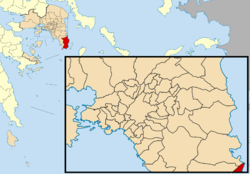Lavreotiki
Λαυρεωτική | |
|---|---|
| Coordinates: 37°43′N 24°4′E / 37.717°N 24.067°E | |
| Country | Greece |
| Administrative region | Attica |
| Regional unit | East Attica |
| Government | |
| • Mayor | Dimitrios Loukas[1] (since 2014) |
| Area | |
| • Municipality | 175.80 km2 (67.88 sq mi) |
| • Municipal unit | 35.484 km2 (13.700 sq mi) |
| Elevation | 10 m (30 ft) |
| Population (2021)[2] | |
| • Municipality | 25,199 |
| • Density | 140/km2 (370/sq mi) |
| • Municipal unit | 10,046 |
| • Municipal unit density | 280/km2 (730/sq mi) |
| Time zone | UTC+2 (EET) |
| • Summer (DST) | UTC+3 (EEST) |
| Postal code | 195 xx |
| Area code(s) | 22920 |
| Website | www.lavreotiki.gr |
Lavreotiki is a municipality at the southeasternnmost tip of the Attica peninsula in the Greek regional unit of East Attica. Its municipal seat is the town of Laurium (Lavrio).[3]
It is historically important as a significant ancient mining district, most notably in the villages of Laurium and Thorikos on the southeastern seaboard during the 6th, 5th, and 4th centuries BCE. As such it financed the wealth of Athens and the emergence of the Athenian Empire through the slave-powered mining efforts for silver and lead, beginning with the discovery of 2 deep-vein mining efforts during the 480's. Prior to that development, which at Themistocles urging in 483 BC led to the expansion of the Athenian fleet to 200 ships, only surface-mining was deployed as a technique for harvesting silver. More than 250 ore washeries have been identified by archaeologists and geologists in the district.
- ^ Municipality of Lavrio, Municipal elections – October 2023, Ministry of Interior
- ^ "Αποτελέσματα Απογραφής Πληθυσμού - Κατοικιών 2021, Μόνιμος Πληθυσμός κατά οικισμό" [Results of the 2021 Population - Housing Census, Permanent population by settlement] (in Greek). Hellenic Statistical Authority. 29 March 2024.
- ^ "ΦΕΚ A 87/2010, Kallikratis reform law text" (in Greek). Government Gazette.

